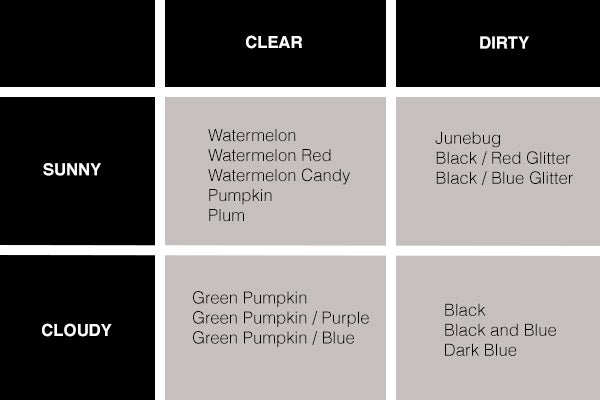It can be hard to choose colors for bass fishing soft plastics. Walking down the bass fishing aisle at any sporting goods store can make your head spin in circles. With endless choices at your fingertips, it’s easy to get carried away. Before you know it, you’ve managed to amass a basket full of baits, and your “quick” shopping trip turns into a major and unexpected expense.
This used to happen to me all the time. I was always afraid of missing out on something. What if I only bought green-pumpkin-colored lizards when the bass really wanted green pumpkin with blue flake? Lord knows I wasn’t about to take the chance, so I’d buy three more packs. It was an endless cycle that left my boat cluttered, my wallet skinny and my mind in knots.
To help you avoid this common problem, we’ve put together a simple guide for choosing colors for bass fishing soft plastics based on the conditions. You can absolutely catch bass on other colors, but this will get you started and put you on the right track for making more informed purchasing and rigging decisions in various situations.
Click here for Black & White Chart for printing
Clear water

It’s important to understand that “clear” is a very relative term in bass fishing. Depending upon geographic location, some anglers consider 30 feet of visibility clear while others believe eight feet of visibility is clear. Rememberâit’s just bass fishing, so try not to overcomplicate it. If you think the water is clear, trust your judgment. You can always make adjustments as the day goes on.
When fishing for clear water bass, it’s important to use natural and often translucent colors. These bass are known to spook at the sight of something unnatural, so beginning with some variation of green is an excellent starting point.
- SunnyâWatermelon-colored soft plastics are very effective when fishing clear water, high sky conditions. Clear water allows for more light penetration, allowing these lighter, more translucent colors to blend in seamlessly with the wary bass’ environment. If you’re having trouble getting bites, try using a watermelon-colored soft plastic or other translucent colors like plum or pumpkin with some sort of shiny glitter in it. These little flakes reflect light very well, drawing more attention to your bait and giving the bass a little extra “something” to hone in on.
- CloudyâWhen faced with lowlight or cloudy conditions in clear water, using darker hues of green and brown and more opaque colors can produce great results. The bass may have trouble locating those translucent colors due to the lack of light penetration, making green pumpkin-colored soft plastics a great choice. They offer a bit more contrast which allows the bass to find your bait easily. If you’re noticing brief periods of sun throughout the day, it’s never a bad idea to add some purple or blue flake to your presentation.
Dirty water

As we discussed with clear water, “dirty” water is also relative in bass fishing. If the water has somewhat of a brown hue to it, often evident after recent precipitation, darker soft plastic colors catch a lot of great bass. You know your favorite fishing holes better than anyone, so again, trust your judgment and remain open to experimentation.
In dirty water situations, it’s important to use soft plastic baits that will contrast well with the surrounding environment. Dark colors create a more noticeable silhouette that the bass detect easily, therefore increasing your chances of getting bites.
- SunnyâDirty water has more sediment than clear water, resulting in lower light penetration. Contrary to popular belief, however, bass can still see fairly well in murky water, especially in sunny conditions. Utilizing dark purple and black-colored soft plastics is an excellent way to increase your bait’s visibility and draw bass from nearby cover. Incorporate some type of red or blue glitter in your baits to take advantage of the sunlight .
- CloudyâCloudy skies and dirty water can make it difficult to get bites on soft plastic baits, but it’s still very possible. The bass may not be able to see long distances, so you need to make your bait’s silhouette as noticeable as possible. This usually means using black and darker colored baitsâor even a combination of the two. Because the bass’ sense of sight is hindered, adding a little scent or even inserting a few glass rattles to your bait can make a big difference.
As you become more comfortable with your soft plastic presentations, you’ll find yourself experimenting with different color combinations. It seems as if every fishery has that “special” regional color the bass can’t seem to resist, and you’ll only crack the code by constant trial and error. This guide, however, hopefully makes a great starting point, grows your confidence and spurs additional, more complex color modifications down the road.








